WCG presents their annual 3-Ring Circus with presentations about What’s Old Is New, Facing Monumental Tasks, and Making Connections.
The Ripley Center, Smithsonian Institution – 1100 Jefferson Dr. SW, Washington DC, 20560

Nearest Metro Stops: Smithsonian (Silver, Blue, Orange), L’Enfant Plaza (Green)
Schedule:
Reception with Exhibitors from 5-6:30pm
Visit each of our exhibitors during the reception to enter the RAFFLE!
Prizes courtesy of: AIC and the International Spy Museum
Exhibitors Include: AIC, Dorfman Museum Figures, Hirox, Hollinger Metal Edge, Smallcorp, Spacesaver Interiors, Tru Vue, and Kremer Pigments.
Presentations from 6:30-7:30pm
See abstracts for these presentations BELOW. See WCG’s YouTube page for recordings of these talks.
This event is free for WCG members, $15 for non-members.
Memberships are $35 for professionals and the 2022/2023 season is free for emerging professionals.
Join or renew at washingtonconservationguild.org/membership.
Our meetings are public, and pictures may appear on WCG’s website and social media accounts.
Follow us on Twitter and Instagram and Facebook!
Programming is made possible with support from the National Collections Program, Kremer Pigments, and FH Conservation:



Abstracts
What’s Old is New
“Diatomaceous Earth Stones for Paper Conservation” by Ewa Paul
The issue of sustainability in the field of conservation is becoming increasingly important. Diatomaceous Earth bath stones (DE stones), a commercial home product, are advertised by their manufacturers to be made of all-natural material. DE stones dry out instantly, prevent bacterial and mold growth and are made without additives. Diatomaceous Earth is similar to Fullers’ Earth which already has its place in the field of conservation. This presentation will explore the use of this commercial product. DE stones have a potential to replace cotton blotters in some drying procedures in paper conservation. Other applications are also possible for example, DE stones can be used as an absorbent pasting out surface or an alternative blotter washing surface. The presentation will focus briefly on the origins of DE and its physical and chemical characteristics, and mention my observations when used during treatments. I will include an FTIR and XRF analyses conducted by Dr. Jennifer Herrmann at the NARA science laboratory.
View a recording of this talk here.
“The use of Agar Gel for the Reduction of Rubber Cement on Photographs” by Maggie Wessling
Agar gel is commonly used for the reduction of adhesives on numerous supports, including photographs. The Photograph Conservation Department at the National Gallery of Art has been experimenting with the application of agar gels to remove deteriorated rubber cement on the rectos and versos of gelatin silver developed-out photographs and dye imbibition photographs. The talk will present results of treatments performed on photographs, as well as tips for casting large sheets of agar and managing the soaking of the gels in solvents. Consideration will be given to the reusability of the gels and extending their working life, given the cost and scarcity of the material.
View a recording of this talk here.
“Re-evaluating the Lilienthal Glider: Where Conservation Meets Restoration” by Deborah Parr
NASM de-installed its Lilienthal glider for conservation assessment and treatment in preparation for the new Gallery, Early Flight. While initial expectations that the conservation treatment would entail surface cleaning and stain reduction, the assessment resulted in a growing list of concerns regarding the accuracy of the presentation of the glider and its future stability. As our understanding of how the glider was originally constructed developed, the scope of the project expanded as we began to consider this an ideal opportunity to reconfigure the gilder and make it closer to its original appearance, to better illustrate its story.
Facing Monumental Tasks
The Eleventh Plague: Responding to a Webbing Clothes Moth Infestation” by Christine Oricchio
A pest infestation is a collections emergency, but they happen so often that collections steward forget to treat them as such. The Smithsonian National Museum of the American Indian (NMAI) has battled with collections pests for decades and is currently responding to one of the worst webbing clothes moth infestations at the collection housing facility in Suitland, Maryland. Of the over 826,000 catalog numbers, more than 75% is comprised of organic material. These items are housed in one large, and open space, across 3 floors, essentially creating a wide-open buffet for pests to enjoy. Though NMAI has successfully responded to several pest infestations in the past, these mitigation events were not organized using emergency management practices. This changed in July of 2022, over 2 years into a pandemic, with limited on-site personnel, when staff discovered an infestation directly effecting 10,000 objects and potentially effecting 50,000 collection items. Since July, NMAI staff are working within the framework of a phased collections emergency response to eliminate the presence of webbing clothes moths and save the collection. Staff involved in the response operate under the incident command system and follow “IARMS,” Inspect, Assess, Respond, Monitor, Salvage. This framework is an example of how to adapt a general emergency response plan for a pest related collections emergency.
View a recording of this talk here.
“Transforming the National Air and Space Museum’s Mannequins” by Elizabeth Knight
NASM has a wide variety of garments from formal and informal attire such as flight uniforms and t-shirts to uniquely fabricated pressure suits with associated hardware components and accessories. The previously used mannequins were not ideal for many of these unique textiles, as they did not allow for customizing each piece best fit the objects. The wide range of materials, designs and components informed our decision to use Ethafoam®-based mannequins suitable for long-term display. This paper will highlight the collaboration between the conservation team and exhibition fabricators who brought specialized skills and expertise to create customized mannequins and auxiliary mounts to support these challenging composite and often heavy objects for display at NASM.
“Laser Removal of Graffiti on Morris Louis’ Beta Upsilon” by Amber Kerr [CANCELLED]
On February 8, 1988 security officers at the museum discovered that the masterwork titled Beta Upsilon by Washington Color School painter Morris Louis had been defaced with two pencil lines drawn directly onto the raw canvas. Initial testing failed to provide an adequate methodology for removing the marks without causing damage to the artwork’s canvas, or driving the graphite further into the textile fibers. The difficult decision was made by conservators, curators, and the Director to remove the painting from view and place it in storage. For over 34 years the artwork has remained in off view while research and experiments were done to find a solution. Over the past several years Senior Paintings conservator Amber Kerr has been collaborating with Bartosz Dajnowski of GC Lasers to design a custom laser to remove the graffiti. This presentation will give an overview of the treatment challenges and discuss the laser treatment that has effectively removed the graffiti, as well as cleaned the exposed raw canvas of this masterpiece from Morris’ unfurled series. The painting is now being prepared for installation in the newly renovated third-floor galleries at SAAM in September 2023.
Making Connections
“Utilizing Existing Infrastructure to Enhance the Archivist/Conservator Relationship” by Mark Coulbourne and Bethany Greenho
In an effort to enhance the communication and relationship between archivists, curators, and conservators utilizing University of Maryland Libraries’ existing infrastructure, UMD Libraries’s Preservation Department and University Archives collaborated to implement guidelines for incorporating conservation documentation in ArchivesSpace records. This presentation will outline the reasoning behind incorporating conservation documentation and detail the guidelines created in collaboration with Elizabeth Caringola, Archival Metadata Librarian. Additionally, we will discuss the use of a shared spreadsheet that details the conservation projects from the past six years that include links to project data, and the time/money that has been spent on projects. Finally, we will discuss the future of this project which may include a public facing aspect.
View a recording of this talk here.
“ECPN Retrospective of the Great Recession: Survey Report” by Keara Teeter and Annabelle Camp
During the first year of the COVID-19 pandemic, AIC’s Emerging Conservation Professionals Network (ECPN) created a survey to capture written histories from mid-career conservators and allied professionals who were emerging conservation professionals (ECPs) during the American Great Recession. The Great Recession included two years of initial economic decline (2007-2009) and was followed by a prolonged period of economic recovery (2010-2014). This survey was intended to reach conservators who earned their Master’s degrees between 2007-2014, with particular emphasis on the ECPs who graduated at the peak of that recession. Their responses were intended to provide ECPs in 2021 with a better understanding of how past economic circumstances have continued to affect the present-day conservation community.
View a recording of this talk here.
“APOYOnline: Looking to the Past and Towards the Future” by Leah Bright
This talk will highlight the rich history of APOYOnline, the Association for Heritage Preservation of the Americas, and discuss our visions for the future. From early translations and printed newsletters to regional conferences and virtual masterclasses, APOYOnline has over 30 years’ experience connecting conservators and heritage preservation professionals across the Americas and in other Spanish and Portuguese speaking countries. With the ubiquity of social media and the new challenges presented by the COVID-19 pandemic, we are now looking to new ways to build bridges between heritage professionals and to provide professional development support.
View a recording of this talk here.